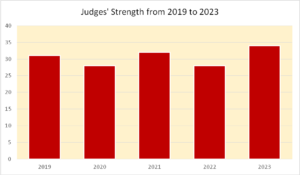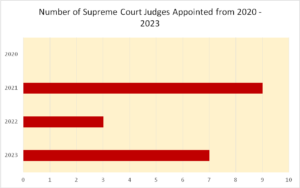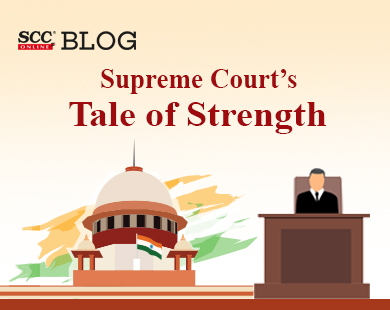Judicial vacancies and appointments are swiftly becoming the flavour of 2023. When Justice Dr D.Y. Chandrachud took up the mantle of Chief Justice of India, filling up of judicial vacancies featured prominently in his “list of objectives”, which included not only District and State Judiciary, but also the Supreme Court.
The preceding year was hectic with its monthly retirements, and the Supreme Court Collegium toiled to fill the gaps. The recommendations for new Judges were made in December 2022 and January 2023, which fructified in February 2023 with the President approving the appointment of 7 Judges-Justice Pankaj Mithal, Justice Sanjay Karol, Justice P.V. Sanjay Kumar, Justice Ahsanuddin Amanullah, Justice Manoj Misra, Justice Rajesh Bindal and Justice Aravind Kumar.
What is significant is that the inclusion of 7 new appointees, has catapulted the number of Judges in the Supreme Court to 34, which is the sanctioned number of Judges as mandated by Section 2 of Supreme Court (Number of Judges) Act, 1956.
However, it is fascinating to note, that originally, the sanctioned strength of Supreme Court Judges was not 34!
Strengthening the Supreme Court- As it Happened1
The Constitution, as drafted, envisaged a Supreme Court with 8 Judges i.e., 1 Chief Justice and 7 puisne Judges, leaving it to Parliament to increase the number if they felt so. As time passed, the workload of the Judges increased, which prompted Parliament to make necessary amends and increase the number of Judges.
-
Did You Know? From 1950 to 2019, Parliament has increased the Supreme Court Judges’ sanctioned strength 6 times!
Merely 6 years after the Constitution of India came into effect; Parliament in 1956 increased the number of Judges from 8 to 11.
Then in 1960, the Judges’ number were increased to 14.
Approximately 18 years later, in 1978, the sanctioned strength of Supreme Court Judges was again increased to 18.
In 1986 the number of Supreme Court Judges was increased to 26 which number carried on until the year 2009, when Parliament again increased the sanctioned strength to 31 Judges.
10 years later, in 2019, the Supreme Court (Number of Judges) Amendment Bill, 2019 was introduced in Parliament, which sought to increase the number of Supreme Court Judges. The Bill was passed, and consequently the Supreme Court’s Judges’ sanctioned strength was increased to 34 Judges.
Trajectory of Supreme Court Appointments from 2019 till present
-
Did You Know? Before February 2023, it was in 2019 [September- November]2 that the Supreme Court had achieved its newly sanctioned strength of 34 Judges.

With the sanctioned strength of the Judges increasing, the appointment of Justices Krishna Murari, S. Ravindra Bhat, V. Ramasubramanian, and Hrishikesh Roy completed the required number for 20193.
However, in 2020, an unprecedented crisis, in the form of Covid-19 pandemic presented itself before the nation and the world. With governments and people dealing with a ‘new normal’, the judiciary also did not remain unaffected. With lockdowns in force, the Supreme Court became immensely focussed on proper disposal of cases, adjusting itself to the wide-spread use of technology. In this pandemonium, there were no appointments to the Supreme Court in 20204.
However, in 2021, the President appointed 9 Supreme Court Judges, including 3 women and a former ASG.
In 2022, however the Supreme Court saw an onslaught of retirements. That year itself, a total 8 Judges, including 2 Chief Justices retired and only 3 new Judges were appointed. By the end of 2022, the retirements and subsequent appointments brought the Judges’ strength to 28 out of 34 Judges.

The Gender Gap
-
Did You Know? From 1950 to 2023, only 11 women Judges have graced the hallowed halls of the Supreme Court, as against 255 male Judges!5
Unlike 2021, no woman Judge was elevated/appointed as a Supreme Court Judge in 2022 and with Justice Indira Banerjee’s retirement, Supreme Court is left with only 3 women judges, who took oath in 2021-
No Rest for the Collegium!
Now that the vacant seats of the Supreme Court have been filled, there will be peace, as the Court will now function at its full strength… for now.
This year, 9 Judges are scheduled to retire. Justice Abdul Nazeer having retired in January, the other 8 Judges are due to bid adieu to the Court later this year6. Remaining Judges who are retiring this year are as follows-
|
Judge’ s Name (on basis of seniority) |
Date of Retirement |
|
Justice Sanjay Kishan Kaul |
25-12-2023 |
|
Justice K.M. Joseph |
16-06-2023 |
|
Justice M.R. Shah |
15-05-2023 |
|
Justice Ajay Rastogi |
17-06-2023 |
|
Justice Dinesh Maheshwari |
14-05-2023 |
|
Justice Krishna Murari |
08-07-2023 |
|
Justice S. Ravindra Bhat |
20-10-2023 |
|
Justice V. Ramasubramanian |
29-06-2023 |
Beginning with May, when Justices M. R. Shah and Dinesh Maheshwari retire, the Judges’ strength will drop to 32.
If the seats vacated in May are not filled, by June, when 3 Judges namely- Justice K.M. Joseph, Justice Ajay Rastogi and Justice V. Ramasubramanian; are set to retire, then the number of Judges in the Supreme Court will drop to 29.
With bulk and back-to-back retirements taking place in May and June, the Supreme Court Collegium will have to be on its toes to fill the vacancies keeping in mind the goals of representation and inclusiveness as highlighted by the current Master of Roster– Justice Dr D.Y. Chandrachud.
Read more about Supreme Court Judges here- Know Thy Judge
*Sucheta Sarkar, Editorial Assistant has prepared this report
1. History of the Supreme Court, Supreme Court of India
2. Supreme Court regains full working strength., The Economic Times
3. New Judges Appointed, SC Observer
4. 63 SC Judges Appointed in the last decade, SC Observer
5. Former Chief Justices and Judges, Supreme Court of India
6. Chief Justice and Judges, Supreme Court of India







